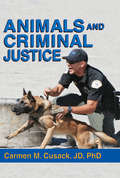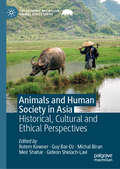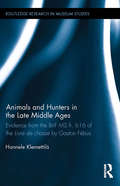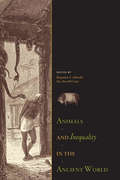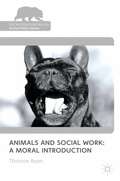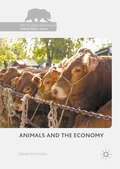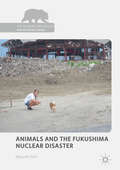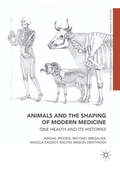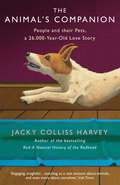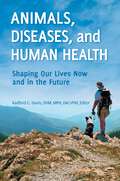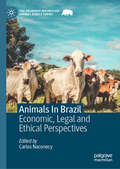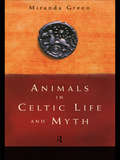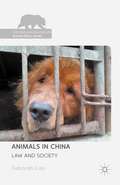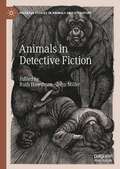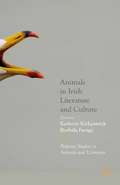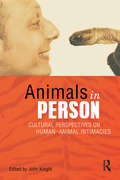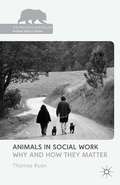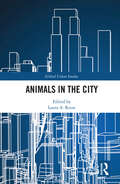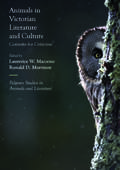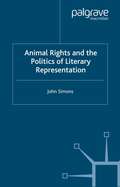- Table View
- List View
Animals and Criminal Justice
by Carmen M. CusackMahatma Gandhi said, "The greatness of a nation and its moral progress can be judged by the way its animals are treated." Since civil societies are ruled by law, they can be evaluated, both figuratively and literally, by how animals are treated in the criminal justice system. This book depicts animals' roles within society and the laws that govern how humans treat them. Carmen M. Cusack focuses on current issues in human-animal relationships and how these are affected by the criminal justice system. Her analysis, while objective, is rooted in first-hand activist, professional, legal, and criminal justice experience. She presents a comprehensive overview of the place of animals and the law, including pets in prison, K-9 units, constitutional rights, animal sacrifice, wild animals, entertainment, domestic violence, rehabilitation, history, and religion. She includes information about law, behavioural and social science, systemic responses and procedure, anecdotal evidence, current events, and theoretical considerations. Animals and Criminal Justice is a useful handbook and a thorough textbook, as well as a practical guide to animals' relationships with the criminal justice system. Professionals, including police, child protective services, judges, animal control officers, and corrections staff, as well as scholars in the fields of criminal justice and criminology will find this book invaluable.
Animals and Human Society in Asia: Historical, Cultural and Ethical Perspectives (The Palgrave Macmillan Animal Ethics Series)
by Rotem Kowner Michal Biran Gideon Shelach-Lavi Meir Shahar Guy Bar-OzThis edited collection offers a comprehensive overview of the different aspects of human-animal interactions in Asia throughout history. With twelve thematically-arranged chapters, this book examines the diverse roles that beasts, livestock, and fish — real and metaphorical– have played in Asian history, society, and culture. Ranging from prehistory to the present day, the authors address a wealth of topics including the domestication of animals, dietary practices and sacrifice, hunting, the use of animals in war, and the representation of animals in literature and art. Providing a unique perspective on human interaction with the environment, the volume is cross-disciplinary in its reach, offering enriching insights to the fields of animal ethics, Asian studies, world history and more.
Animals and Hunters in the Late Middle Ages: Evidence from the BnF MS fr. 616 of the Livre de chasse by Gaston Fébus (Routledge Research in Museum Studies)
by Hannele KlemettiläThis book explores views of the natural world in the late Middle Ages, especially as expressed in Livre de chasse (Book of the Hunt), the most influential hunting book of the era. It shows that killing and maiming, suffering and the death of animals were not insignificant topics to late medieval men, but constituted a complex set of issues, and could provoke very contradictory thoughts and feelings that varied according social and cultural milieus and particular cases and circumstances.
Animals and Hunters in the Late Middle Ages: Evidence from the BnF MS fr. 616 of the Livre de chasse by Gaston Fébus (Routledge Research in Museum Studies)
by Hannele KlemettiläThis book explores views of the natural world in the late Middle Ages, especially as expressed in Livre de chasse (Book of the Hunt), the most influential hunting book of the era. It shows that killing and maiming, suffering and the death of animals were not insignificant topics to late medieval men, but constituted a complex set of issues, and could provoke very contradictory thoughts and feelings that varied according social and cultural milieus and particular cases and circumstances.
Animals and Inequality in the Ancient World
by Benjamin S. Arbuckle and Sue Ann McCartyAnimals and Inequality in the Ancient World explores the current trends in the social archaeology of human-animal relationships, focusing on the ways in which animals are used to structure, create, support, and even deconstruct social inequalities. The authors provide a global range of case studies from both New and Old World archaeology—a royal Aztec dog burial, the monumental horse tombs of Central Asia, and the ceremonial macaw cages of ancient Mexico among them. They explore the complex relationships between people and animals in social, economic, political, and ritual contexts, incorporating animal remains from archaeological sites with artifacts, texts, and iconography to develop their interpretations. Animals and Inequality in the Ancient World presents new data and interpretations that reveal the role of animals, their products, and their symbolism in structuring social inequalities in the ancient world. The volume will be of interest to archaeologists, especially zooarchaeologists, and classical scholars of pre-modern civilizations and societies.
Animals and Social Work: A Moral Introduction (The Palgrave Macmillan Animal Ethics Series)
by T. RyanSocial Work and Animals represents a pioneering contribution to the literature of social work ethics and moral philosophy. It advances cogent and detailed arguments for the inclusion of animals within social work's moral framework, arguments that have profound theoretical and practical implications for the discipline and its practitioners.
Animals and the Economy (The Palgrave Macmillan Animal Ethics Series)
by Steven McMullenThis book explores the economic institutions that determine the nature of animal lives as systematically exploited objects traded in a market economy. It examines human roles and choice in the system, including the economic logic of agriculture, experimentation, and animal ownership, and analyses the marginalization of ethical action in the economic system. Animals and the Economy demonstrates that individual consumers and farmers are often left with few truly animal-friendly choices. Ethical participants in the economy must either face down an array of institutional barriers, or exit mainstream markets entirely. This book argues that these issues are not necessary elements of a market system, and evaluates a number of policy changes that could improve the lives of animals in the context of a market economy.
Animals and the Fukushima Nuclear Disaster (The Palgrave Macmillan Animal Ethics Series)
by Mayumi ItohThis book is the first comprehensive, in-depth English language study of the animals that were left behind in the exclusion zone in the wake of the nuclear meltdown of three of the four reactors at the Fukushima Daiichi Nuclear Power Station in March 2011, triggered by the Great East Japan Earthquake of magnitude 9.0.The Japanese government designated an area of 20-kilometer radius from the nuclear power station as an exclusion zone and evacuated one hundred thousand residents, but left companion animals and livestock animals behind in the radioactive area. Consequently, about 90 percent of the animals in the exclusion zone died. This book juxtaposes policies of the Japanese government toward the animals in Fukushima with the actions of grassroots volunteer animal rescue groups that filled the void of the government.
Animals and the Shaping of Modern Medicine: One Health and its Histories
by Angela Cassidy Abigail Woods Michael Bresalier Rachel Mason DentingerThis book is open access under a CC BY 4.0 license.This book breaks new ground by situating animals and their diseases at the very heart of modern medicine. In demonstrating their historical significance as subjects and shapers of medicine, it offers important insights into past animal lives, and reveals that what we think of as ‘human’ medicine was in fact deeply zoological.Each chapter analyses an important episode in which animals changed and were changed by medicine. Ranging across the animal inhabitants of Britain’s zoos, sick sheep on Scottish farms, unproductive livestock in developing countries, and the tapeworms of California and Beirut, they illuminate the multi-species dimensions of modern medicine and its rich historical connections with biology, zoology, agriculture and veterinary medicine. The modern movement for One Health – whose history is also analyzed – is therefore revealed as just the latest attempt to improve health by working across species and disciplines. This book will appeal to historians of animals, science and medicine, to those involved in the promotion and practice of One Health today.
Animals and the Shaping of Modern Medicine: One Health and its Histories
by Abigail Woods Michael Bresalier Angela Cassidy Rachel Mason DentingerThis book is open access under a CC BY 4.0 license.This book breaks new ground by situating animals and their diseases at the very heart of modern medicine. In demonstrating their historical significance as subjects and shapers of medicine, it offers important insights into past animal lives, and reveals that what we think of as ‘human’ medicine was in fact deeply zoological.Each chapter analyses an important episode in which animals changed and were changed by medicine. Ranging across the animal inhabitants of Britain’s zoos, sick sheep on Scottish farms, unproductive livestock in developing countries, and the tapeworms of California and Beirut, they illuminate the multi-species dimensions of modern medicine and its rich historical connections with biology, zoology, agriculture and veterinary medicine. The modern movement for One Health – whose history is also analyzed – is therefore revealed as just the latest attempt to improve health by working across species and disciplines. This book will appeal to historians of animals, science and medicine, to those involved in the promotion and practice of One Health today.
The Animal's Companion: People and their Pets, a 26,000-Year Love Story
by Jacky Colliss HarveyThe earliest evidence of a human and a pet can be traced as far back as 26,000 BC in France where a boy and his 'canid' took a walk through a cave. Their foot and paw prints were preserved together on the muddy cave floor, and smoke from the torch the boy carried was left on the walls, allowing archaeologists to carbon-date their journey. And so, the story unfolds, from these prehistoric days all the way up to the present, of our innate and undeniable need to live in the close company of animals. In this startling new work, acclaimed cultural detective and lifelong pet owner Jacky Colliss Harvey uses her compelling storytelling skills and keen eye for historical investigation to examine our role as animals' companions, in this exploration of the history not of the pet, but of us as pet owners. Drawing on literary, artistic and archaeological evidence of our relationships with other species, over thousands of years of human experience, she examines the when, the how and the why of our connection to those animals we take into our lives, assessing these against the latest scientific thinking on this complex and enthralling subject, and suggesting new insights into this most long-standing of all human love-affairs.
Animals, Diseases, and Human Health: Shaping Our Lives Now and in the Future
by Radford G. DavisThis book explains how animals shape our lives and our health, providing evidence that a "One Health" approach is the only logical methodology for advancing human health in the future.Modern research shows us that disease and health of animals and people are intrinsically connected. The condition of the environment we share with animals is now understood to be a primary factor in establishing the health of both humans and animals. This concept is the basis of the One Health movement, which strives to expand interdisciplinary collaborations and communications in all aspects of health care for humans and animals worldwide.Animals, Diseases, and Human Health: Shaping Our Lives Now and in the Future is written by leading experts in their fields and is centered around topics that are most relevant to the overlap and connection of animal and human health. Topics covered include human health concerns derived from animals such as allergies and dog bites, global concerns of emerging diseases and pandemics, wildlife smuggling, animal abuse, and common diseases that can stem from popular household pets. Social issues—such as the connection between animal abuse and human violence—are also examined.
Animals In Brazil: Economic, Legal and Ethical Perspectives (The Palgrave Macmillan Animal Ethics Series)
by Carlos NaconecyThis book presents a collection of essays exploring the legal, economic, socio-environmental, and ethical dimensions of human-animal interaction in Brazil. As one of the primary global producers and exporters of beef, with a level of biodiversity in its rain-forests found nowhere else under threat, the importance of Brazil for animal life is unquestionable. Shedding light on the profound transformations in the consumption and production of animal-sourced foods that have taken place over the last five decades, the authors examine the consequences of this phenomenon for the lives of animals, the health of the population, and the environment. The book also offers an analysis of the animal welfare and animal protection legislation in Brazil, before presenting a number of notable cases involving animal advocacy and activism in recent years. An important and timely collection, this book concludes with an exploration of the historical, socio-cultural and economic aspects that influence the Brazilian ethos regarding the morality of the treatment of animals.
Animals in Celtic Life and Myth
by Miranda GreenAnimals played a crucial role in many aspects of Celtic life: in the economy, hunting, warfare, art, literature and religion. Such was their importance to this society, that an intimate relationship between humans and animals developed, in which the Celts believed many animals to have divine powers. In Animals in Celtic Life and Myth, Miranda Green draws on evidence from early Celtic documents, archaeology and iconography to consider the manner in which animals formed the basis of elaborate rituals and beliefs. She reveals that animals were endowed with an extremely high status, considered by the Celts as worthy of respect and admiration.
Animals in Celtic Life and Myth
by Miranda GreenAnimals played a crucial role in many aspects of Celtic life: in the economy, hunting, warfare, art, literature and religion. Such was their importance to this society, that an intimate relationship between humans and animals developed, in which the Celts believed many animals to have divine powers. In Animals in Celtic Life and Myth, Miranda Green draws on evidence from early Celtic documents, archaeology and iconography to consider the manner in which animals formed the basis of elaborate rituals and beliefs. She reveals that animals were endowed with an extremely high status, considered by the Celts as worthy of respect and admiration.
Animals in China: Law and Society (The Palgrave Macmillan Animal Ethics Series)
by Deborah CaoJust as China is called the world factory for manufactured goods, it is also a world factory for manufactured animal cruelty in a new phenomenon of globalized animal cruelty. Animals in China examines animal protection in China in its legal, social and cultural contexts.
Animals in Detective Fiction (Palgrave Studies in Animals and Literature)
by Ruth Hawthorn John MillerThis book explores the vast array of animals that populate detective fiction. If the genre begins, as is widely supposed, with Edgar Allan Poe’s “Murders in the Rue Morgue” (1841), then detective fiction’s very first culprit is an animal. Animals, moreover, consistently appear as victims, clues, and companions, while the abstract conception of animality is closely tied to the idea of criminality. Although it is often described as an essentially conservative form, detective fiction can unsettle the binary of human and animal to intersect with developing concerns in animal studies: animal agency, the ethical complexities of human/animal interaction, the politics and literary aesthetics of violence, and animal metaphor. Gathering its 14 essays into sections on ontologies, ethics, politics, and forms, Animals in Detective Fiction provides a compelling and nuanced analysis of the central role creatures play in this enduringly popular and continually morphing literary form.
Animals in Irish Literature and Culture (Palgrave Studies in Animals and Literature)
by Kathryn Kirkpatrick Borbála FaragóAnimals in Irish Literature and Culture spans the early modern period to the present, exploring colonial, post-colonial, and globalized manifestations of Ireland as country and state as well as the human animal and non-human animal migrations that challenge a variety of literal and cultural borders.
Animals in Person: Cultural Perspectives on Human-Animal Intimacies
by John KnightOur relationship with animals is complex and contradictory; we hunt, kill and eat them, yet we also love, respect and protect them. This ambivalent relationship is further complicated by the fact that we attribute human emotions and intelligence to animals. We even go as far as likening them to children and treating them as family members. Drawing on a diverse range of case studies, Animals in Person attempts to unravel our close and fascinating link with the animal kingdom. This book highlights the theme of cross-species intimacy in contexts such as livestock care, pet keeping, and the use of animals in tourism. The studies draw on data from different parts of the world, including New Guinea, Nepal, India, Japan, Greece, Britain, The Netherlands and Australia. Animals in Person documents the existence of relations between humans and animals that, in many respects, recall relations among humans themselves.
Animals in Person: Cultural Perspectives on Human-Animal Intimacies
Our relationship with animals is complex and contradictory; we hunt, kill and eat them, yet we also love, respect and protect them. This ambivalent relationship is further complicated by the fact that we attribute human emotions and intelligence to animals. We even go as far as likening them to children and treating them as family members. Drawing on a diverse range of case studies, Animals in Person attempts to unravel our close and fascinating link with the animal kingdom. This book highlights the theme of cross-species intimacy in contexts such as livestock care, pet keeping, and the use of animals in tourism. The studies draw on data from different parts of the world, including New Guinea, Nepal, India, Japan, Greece, Britain, The Netherlands and Australia. Animals in Person documents the existence of relations between humans and animals that, in many respects, recall relations among humans themselves.
Animals in Social Work: Why and How They Matter (The Palgrave Macmillan Animal Ethics Series)
by Thomas RyanThis collection of essays articulates theoretical and philosophical arguments, and advances practical applications, as to why animals ought to matter to social work, in and of themselves. It serves as a persuasive corrective to the current invisibility of animals in contemporary social work practice and thought.
Animals in the City (Global Urban Studies)
by Laura A. ReeseThis book presents interdisciplinary research to examine the ongoing debates around nonhuman animals in urban spaces. It explores how we can better appreciate and accommodate animals in the city, while also exploring the ecological, health, ethical, and cultural implications of the same. The book addresses seven interrelated themes such as blurred boundaries between the human and the nonhuman, the right of nonhuman species to the city, interactions between the human and nonhuman animals, the fabric of urban space, human and nonhuman complex systems, and collective welfare that forms the basis of a transspecies urban theory. It explains how a holistic understanding of the city requires that these blurred boundaries are acknowledged and critically examined. Chapters analytically consider the need to bring interspecies relationships to the fore to tackle questions of legitimacy and who has the "right" to the city. These also consider important intersections between the economic, political, social, and cultural aspects of the urban experience. The research contained in this book focuses on the development of an urban theory that would eradicate the divide between humans and other species in cities, and it depicts nonhuman animals as social actors that have voices within urban spaces. With global insights on human–animal relationships in a contemporary context, this book will be useful reading for scholars and students of urban studies, animal sciences, animal law, animals and public policy, anthropology, and environmental studies who are interested in the study of animals in cities.
Animals in the City (Global Urban Studies)
by Laura A. ReeseThis book presents interdisciplinary research to examine the ongoing debates around nonhuman animals in urban spaces. It explores how we can better appreciate and accommodate animals in the city, while also exploring the ecological, health, ethical, and cultural implications of the same. The book addresses seven interrelated themes such as blurred boundaries between the human and the nonhuman, the right of nonhuman species to the city, interactions between the human and nonhuman animals, the fabric of urban space, human and nonhuman complex systems, and collective welfare that forms the basis of a transspecies urban theory. It explains how a holistic understanding of the city requires that these blurred boundaries are acknowledged and critically examined. Chapters analytically consider the need to bring interspecies relationships to the fore to tackle questions of legitimacy and who has the "right" to the city. These also consider important intersections between the economic, political, social, and cultural aspects of the urban experience. The research contained in this book focuses on the development of an urban theory that would eradicate the divide between humans and other species in cities, and it depicts nonhuman animals as social actors that have voices within urban spaces. With global insights on human–animal relationships in a contemporary context, this book will be useful reading for scholars and students of urban studies, animal sciences, animal law, animals and public policy, anthropology, and environmental studies who are interested in the study of animals in cities.
Animals in Victorian Literature and Culture: Contexts for Criticism (Palgrave Studies in Animals and Literature)
by Laurence W. Mazzeno Ronald D. MorrisonThis collection includes twelve provocative essays from a diverse group of international scholars, who utilize a range of interdisciplinary approaches to analyze “real” and “representational” animals that stand out as culturally significant to Victorian literature and culture. Essays focus on a wide range of canonical and non-canonical Victorian writers, including Charles Dickens, Anthony Trollope, Anna Sewell, Emily Bronte, James Thomson, Christina Rossetti, and Richard Marsh, and they focus on a diverse array of forms: fiction, poetry, journalism, and letters. These essays consider a wide range of cultural attitudes and literary treatments of animals in the Victorian Age, including the development of the animal protection movement, the importation of animals from the expanding Empire, the acclimatization of British animals in other countries, and the problems associated with increasing pet ownership. The collection also includes an Introduction co-written by the editors and Suggestions for Further Study, and will prove of interest to scholars and students across the multiple disciplines which comprise Animal Studies.
Animals, Literature and the Politics of Representation
by J. SimonsThis book addresses the question of animal rights in the context of literary criticism. Working from a committed position, it asks the question, 'What would literary studies look like if we took animal rights seriously?' It offers critical surveys of the main themes in the history of animal rights and some of the more important contemporary positions together with readings of a wide range of literary texts from classical antiquity to the present day.
